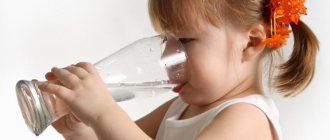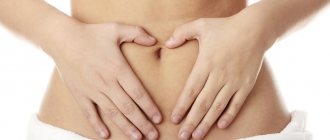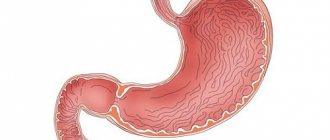When a child has diarrhea with mucus, many mothers begin to panic. However, there are practically no children who did not suffer from diarrhea under 2 years of age. Of course, digestive disorders bring a lot of trouble to parents and the child himself, but there is nothing to worry about.
But if the color or consistency of the stool changes greatly during diarrhea (for example, mucus appears, blood clots appear, the stool becomes black, yellow or green), then you need to think about the fact that there are many factors that provoke such deviations. The child must be shown to a doctor.
Symptoms of diarrhea in a child
Diarrhea is a disease accompanied by bowel movements that occurs repeatedly. Diarrhea is not a separate disease, because... this is only a consequence of the processes that occur in the body. Digestive disorders in a child are associated with the fact that his intestines are very susceptible to various microorganisms and are sensitive. Moreover, these same microorganisms at an older age (in a year or several) will not be so dangerous.
As for the symptoms, diarrhea in a child is accompanied by the fact that the stool becomes liquid. In addition, the number of bowel movements increases to 7-10 times a day. When a child has diarrhea, the stomach may swell. In addition, the baby complains of pain in this area. It is imperative to monitor the condition of the stool and pay attention to its consistency and color. Due to discomfort and pain, the child may become restless and cry.
Types of diarrhea in a child
Doctors say that diarrhea in children is provoked by infectious and non-infectious factors.
Diarrhea is divided into functional and organic. A functional disorder is characterized by the absence of disturbances in the structure of the digestive organs. With organic diarrhea, changes occur in the structure of the digestive organs.
Depending on the severity of the course, diarrhea is classified into acute and chronic types.
Acute
Most often, acute diarrhea occurs in children whose age is too young, due to the lack of basic sanitary and hygienic skills in the baby, due to weak defense mechanisms. Often, a child acquires symptoms of the disease through dirty hands, contact with contaminated toys, or pets.
If a little one is one and a half years old, it is impossible to explain the rules of personal hygiene to him. But a three-year-old child should be taught basic hygiene skills, including washing hands before eating and after using the toilet.
The acute form of the disease is accompanied by fever and abdominal pain. This diarrhea goes away after 3 days with adequate treatment.
Chronic
The disease is characterized by frequent bowel movements and loose stools lasting more than four weeks. The baby complains of abdominal pain. No appetite. Diarrhea is accompanied by nausea and vomiting.
Chronic stomach upset is a reason to consult a doctor. Prolonged diarrhea causes dehydration of the child’s body, which can lead to dire consequences, including death.
Change in stool color
As foods are digested, fermentation will intensify. This leads to the coloring of substances in a greenish tint. With dysentery, stool becomes this color in some cases. Symptoms that appear along with an unusual shade of stool are fever, nausea, vomiting, pain in the abdomen, weakness, and lethargy. The child must be checked for the presence of pathological processes in the liver, because With diarrhea, feces may also become greenish due to problems with the liver. This is due to the fact that red blood cells break down and bilirubin is formed in the liver. When it enters the intestines, the stool takes on this unusual color. To diagnose the condition of a small patient, you need to conduct a stool test and take a bacteriological culture. If an infant's stool is this color, it may be because food is being rejected. In this case, not only mucus appears, but also foam and streaks. If a child has diarrhea with mucus, what should parents do? First of all, you urgently need to take the baby to the hospital.
Mucous liquid stools: characteristic features
Depending on the nature of the inflammatory process, mucus may have different colors and consistency.
- With catarrhal inflammation of the intestinal wall, a clear, watery secretion is released.
- With suppuration caused by pathogenic bacteria, the mucus has a greenish-yellow color.
- When the mucous membrane is ulcerated, the mucus is pinkish in color and may contain streaks of blood.
- With salmonellosis, loose stool with mucus has a swamp color.
- With staphylococcal enterocolitis, the stool is foamy yellow diarrhea with mucus.
- With dysentery, green purulent patches and streaks of blood are found in the stool.
- With viral intestinal infections, the child experiences profuse, watery, green diarrhea with mucus and whitish lumps.
- When the intestines are damaged by yeast-like fungi from the genus Candida, the mucus, due to the ingress of fungal mycelium into it, is white.
Diarrhea and blood discharge
When blood clots come out with stool, the most likely cause is hemorrhoids. Vein nodes form in the rectum. The blood vessels begin to bleed, so that when you defecate, you can find bloody stool in the child. However, children rarely develop this disease. Blood in a child's stool may be due to different pathogenic strains affecting the large intestine. Cracks may also appear in the anus.
In some cases, oncological pathologies of the rectum can also be the causes of this phenomenon. If the blood in the stool is bright red, it may be released when the intestinal walls begin to bulge.
The symptoms that accompany the appearance of blood in the stool are pain not only in the stomach, but also in the rectal area. The pain in the intestines especially increases during bowel movements and at the end of the bowel movement. There may be mucus in the stool. Sometimes yellow diarrhea appears. Also characterized by fever, nausea and vomiting attacks. For diagnosis you need to do endoscopy and radiography. If children are bleeding profusely, then emergency help is needed.
Causes of mucous diarrhea
The danger to the child is most often associated with the risk of severe dehydration, as well as a rise in temperature. In some cases, stopping diarrhea without the help of doctors and special therapy can be too difficult.
READ MORE: Cough, runny nose and fever in a child
If a child develops greenish diarrhea with lumps, in newborns this may indicate congenital defects. When these same symptoms occur in older children, they may have to deal with an infectious disease.
Black diarrhea
In some cases, stool with diarrhea acquires a dark, almost black tint. This may be due to the fact that the baby previously consumed activated carbon or certain types of mineral or vitamin complexes. If a child has black diarrhea, the cause may be internal bleeding.
For example, the intestines, stomach, and esophagus can bleed. Such phenomena are associated with the following severe pathologies:
- oncological processes;
- peptic ulcer of the stomach or duodenum;
- dilation of veins in the esophagus;
- polyps.
Along with black feces, the child may experience anemia, headaches and dizziness, a feeling of weakness and lethargy. The skin of the face begins to turn pale. If such symptoms appear, you need to take your child to the hospital as soon as possible. Colonoscopy and fibroesophagogastroduodenoscopy are used for diagnosis.
Treatment of diarrhea
The therapy for infants is the same, for those who are older it is somewhat different. Newborns should not be stopped feeding. Rather, on the contrary, after each bowel movement the baby should be put to the breast for feeding. If he refuses, you need to give him a lot of water from a teaspoon. You can use rehydration solutions.
To treat newborns for diarrhea, it is better to call a local pediatrician. Ambulance is necessary if the fever persists and the diarrhea does not stop. Until the specialist arrives, it is better to keep the diaper in order to show the nature of the bowel movements to the doctor. This will make it easier for him to make a diagnosis and choose the right treatment.
If the stool contains mucus impurities, treatment should not include drugs that slow down the passage of stool through the intestines. This method of therapy can only slow down the child’s recovery and increase intoxication. You cannot use Loperamide or Levomycetin. Such medications can only be prescribed by a doctor after examination.
When the child is older, feeding is stopped during diarrhea. Only clean water and unsweetened tea are allowed. Sorbents are used. It is important to give your child enough to drink. You should stick to a diet for some time after the symptoms subside. We wrote here what you can feed a child with diarrhea.
Causes of mucus during diarrhea
With diarrhea, the course of the disease can be different. Your child may have loose, watery, or mush-like stools. In some cases, not only mucus appears, but blood clots and pus. The feces may be of a non-standard color (green), too light (almost yellow) or, conversely, almost black. The smell may be sour or foul, the stool may be shiny or greasy, contain pieces of food or, conversely, be homogeneous.
Diarrhea with mucus in a child mainly appears due to the removal of water and salts from the small intestine. In this case, the causative agents of the disease are various pathogenic microorganisms or substances of a pathogenic nature. For example, these could be Giardia, Cryptosporidium, Rotavirus, Salmonella, Enterovirus.
Diarrhea in children under 2 years of age can be caused by dietary disturbances (for example, a change in diet) or failure to comply with hygiene rules. Diarrhea in a child can develop for the following reasons:
- due to infections in the intestines;
- for colds;
- when using drugs from the group of antibiotics;
- due to severe overexcitation;
- due to changes in weather conditions or climate zone;
- due to teething.
If there is fat and mucus in the stool, then most likely the cause is an infectious disease, so you definitely need the help of a qualified doctor. If the stool, on the contrary, is more watery with a higher content of mucous substances, then the reason is an infection of the intestinal type. Mucus during bowel movements in a child is sometimes caused by enterocolitis, gastroenteritis or other diseases of the digestive tract. Diverticulitis is also dangerous for the baby, and he may have a similar symptom.
In parallel with this symptom, diarrhea in a child can provoke pain in the abdomen, intestines, rectum and anus. In addition, there is an excessive intensity of gas formation, bloating, rumbling, weakness, malaise, and nausea. Due to insufficient functioning, this problem can also arise. For example, this is often associated with improper, insufficiently balanced nutrition or a sudden change in the regime or diet for children.
Causes of diarrhea in a child
Before taking measures to eliminate diarrhea, you need to identify the cause of the disease. Diarrhea is caused by various factors. The consumption of foods and liquids unfamiliar to the body can provoke loose stools. In the latter case, you will need to adjust your diet, the symptoms will disappear.
Sometimes serious illnesses can be the cause of frequent loose stools. Salmonellosis, dysentery, and viral infection are accompanied by diarrhea. Doctors often diagnose viral diarrhea, which is caused by rotavirus.
Causes of loose stools:
- Reaction to drugs;
- Lactose intolerance in a newborn;
- Food poisoning;
- Such a reaction of the body develops from emotional overstrain.
Children under two years of age experience discomfort during teething. When taking antibiotics, a side effect is severe diarrhea.
How to help a child with diarrhea with mucus?
What to do if a child has diarrhea with mucus? If you notice such a symptom, you should definitely call a doctor as soon as possible. In addition, you must immediately stop any eating. While the parents are waiting for the doctor, you can give the child a mixture of salt, sugar and water. The product is prepared as follows: for 1 liter of water you need a spoonful of sugar and salt. This will help prevent symptoms of dehydration due to diarrhea. After each act of defecation, the child must be washed. This will help prevent irritation in the anal canal. Then this place needs to be smeared with baby cream. In order to carry out diagnostics, you need to transfer the contents of the pot into a jar and close the container tightly. To reduce dehydration, your baby can be given Oralit or Regidron. Before use, the product must be dissolved in water. Further treatment is prescribed by the doctor if diarrhea is caused by other pathologies and problems of organs and systems.
After the doctor has examined the child and prescribed appropriate treatment, you need to adhere to certain nutritional rules for the next few weeks. You should try to eliminate from your diet all foods that have irritating properties. The following products are prohibited:
- coffee;
- chocolate;
- juices;
- citrus;
- fresh vegetables and fruits;
- berries;
- fatty, overly salty, fried foods;
- spices;
- smoked meats;
- marinades;
- carbonated drinks.
Infants should not be given milk other than breast milk. All dairy products will also have to be excluded. You need to include buckwheat, crackers, potatoes (baked, mashed or boiled), bananas, and boiled vegetables in your diet. Rice is very healthy because... It not only has adhesive properties, but is also a natural sorbent that allows you to quickly remove harmful substances from the body. All dishes should be mushy to reduce stress on the stomach.
If a child has diarrhea with mucus, then you need to see a doctor and not treat the baby yourself. This may be due to various infections that simply cannot be eliminated without drug therapy.
source: rebenokzabolel.ru
Loose stools are a digestive disorder that is common in children of all ages. Diarrhea is not always a pathology; sometimes it is the result of dietary errors or stress. Of course, it causes a lot of discomfort to both the child and his parents. What to do to get rid of this problem, and what signs should you pay attention to?
Mucous diarrhea in children can appear for various reasons. Among them:
- long-term use of antibiotics;
- teething, climate change;
- infectious diseases of varying severity;
- non-compliance with diet (incorrect introduction of complementary foods);
- acute intestinal infection;
- insufficiency of digestive enzymes (manifests in the first months of the baby’s life);
- inflammatory pathologies of the digestive tract (colitis, enteritis, gastritis, gastroenteritis).
Reasons such as teething and climate change are completely harmless and do not require therapy. Infectious diseases and disorders of the gastrointestinal tract can pose a threat to the health and life of a one-year-old child.
Prevention of intestinal disorders in children
To avoid intestinal difficulties, it is important to follow simple rules. First of all, you need to teach children to wash their hands after walking and before eating. Adults should thoroughly wash vegetables and fruits and cook meat and fish.
Babies under one year old explore the world around them with great interest, while tasting rattles, toys and everything that comes to hand. Parents should regularly wash toys and carry out wet cleaning in places where the baby plays. It is necessary to exercise constant control over the little one.
Children aged 6 are already old enough to understand what adults say. It is worth explaining that you cannot drink water from reservoirs while swimming during the summer holidays, as well as tap water.
If diarrhea occurs frequently for no apparent reason and does not go away for a long time, and you cannot cure it on your own, you should consult a doctor and inform him about the diarrhea. The doctor may prescribe an examination of the gastrointestinal tract, identifying pathologies accompanied by an unpleasant symptom.
Diarrhea occurs in people of all ages. It occurs even more often in children, because their digestive system is more sensitive to all negative influences. Loose stools in infants are generally considered normal. But when mucus appears, you need to be wary. Even if it is a little, this is evidence of irritable bowel.
But irritable bowel in itself is not a disease. Most likely, this is a reaction to unusual bacteria in the digestive system. Older children's bodies are calm about new foods. But children who have not yet reached 2 years of age can react strongly to even the most common complementary foods or to a change in the number of meals.
Diarrhea as a symptom of pathology
The development of an infectious disease can be suspected based on the following symptoms:
- Deterioration of the child's general condition, high temperature.
- The presence of fat or streaks of blood in the stool. Bloody stools with mucus may indicate infection with enterohemorrhagic bacteria, Aeromonas, or Shigella.
- Fetid odor of stool.
- The presence of greenish lumps with red streaks in the stool is a specific symptom of a dysentery infection.
- The stool is yellow or green with orange flakes.
- Mucous stools occurring with a frequency of 6 times a day. When assessing the frequency of bowel movements, emphasis should be placed on the age of children. Thus, in a child under the age of 1 month, the frequency of bowel movements normally reaches 6-7 times a day, while in a one-year-old baby this is a deviation from the norm.
The most dangerous complication of diarrhea is dehydration, which is accompanied by disruption of important metabolic processes in the body. This especially needs to be taken into account in children under 3 years of age - their systems for regulating water balance are not fully formed.
What to do
Long-term diarrhea in children is very dangerous. In a short time it leads to dehydration of the body. The criteria for this condition are drowsiness, soft eyeballs, dry lips, feet and palms, dry skin, thick and sticky saliva, lack of urination for 8-12 hours. Therefore, do not waste time and start treatment.
First of all, restore the water-salt balance caused by diarrhea. Give the patient sweet tea and saline solutions (Oralit, Acesol, Regidron). If the child refuses to drink, give liquid in small portions (0.5 tsp) every 10 minutes. To monitor the amount of fluid lost, try to weigh the patient after the next bowel movement. Save the contents of the pot in a jar until the doctor arrives for better diagnosis.
To reduce the effect of toxins, give your child a sorbent. Read the instructions carefully and check at what age the drug can be used. For children under 6 months, Filtrum STI and Smecta are approved. Children aged 1 year and older can be given Polysorb. Activated carbon can be used at any age.
If the temperature rises above 38 ° C, give the child an antipyretic drug. Clean your baby after each bowel movement to reduce irritation of the anus. You can also lubricate your butt with baby cream.
Treatment methods
There are special drugs that can block dyspeptic symptoms. They should be used with caution, only after consultation with a specialist.
The fact is that for some conditions, taking such medications is not recommended. For example, in case of poisoning, you should not stop diarrhea and vomiting on the first day, since this is how the body’s defense mechanisms work. Therefore, the decision to administer drugs is made by the doctor.
Parents must remember that all they can do to help their child is to give the simplest sorbents and rehydration medications. In a critical situation, you can give your baby a children's antipyretic.
If there is a suspicion of poisoning, it is necessary to rinse the stomach immediately after the first signs appear. In order to help the body cope with intoxication, sorbent drugs are given. To relieve vomiting and diarrhea, doctors prescribe medications such as Motilium and Loperamide.
After relieving acute symptoms, care must be taken to restore the intestinal microflora. To do this, the doctor may recommend taking medications such as Linex, Bifidumbacterin, Lactofiltrum.
If a child is diagnosed with an allergy, antihistamines are prescribed. In case of poisoning, it is recommended to take antispasmodics to relieve abdominal pain, for example, No-shpu. If diagnostics reveals diseases of the stomach, liver or other organs, special drugs are prescribed to treat them.
Diet for diarrhea
Treatment of diarrhea necessarily includes diet. In babies who are breastfed, the risk of developing diarrhea complications is much lower than in bottle-fed babies. Take advantage of this feature - put your baby to the breast more often and reduce the number of complementary foods. This will help quickly restore the body's water balance.
Feed older children more often and in smaller portions. During the day, the child should consume the amount of food that was lost with the previous bowel movement. In this case, you need to exclude any irritating food from your diet. Milk (not including breast milk), juices, fatty and solid foods, fresh fruits and vegetables, and gas-forming products are also contraindicated.
Include foods such as potatoes, rice, bananas, buckwheat, boiled vegetables, crackers, dietary soups, tea in your child’s diet. Food should have a mushy consistency so as not to overload the stomach. Since intestinal function is not restored immediately, normal nutrition should be returned gradually as the patient’s stool improves.
Many causes of diarrhea in children can threaten their health and life. Therefore, you should not hesitate to seek medical help. Only with timely and correct identification of the cause of diarrhea is it possible to carry out effective therapy. In this case, the consequences for the baby will be minimal.
source: mezhdunami.net
All children, both infants and preschool children, suffer from digestive disorders. It is characterized by dilution of stool, increased frequency of bowel movements, and the presence of pathological impurities.
Attention! Diarrhea with mucus in a child can pose a health hazard because it is accompanied by the removal of large amounts of fluid from the body, loss of nutrients and electrolytes, which leads to dehydration, intoxication and exhaustion of the child’s body.
How to adjust your diet
Why might a child under one year old have bad urine?
When a newborn poops mucus, it may indicate lactase deficiency. This is the name for a condition when a child does not digest the sugars contained in breast milk due to imperfections in the digestive system and a lack of certain enzymes. If a child has diarrhea with mucus after breastfeeding, this diagnosis is 90% correct. In this case, the doctor will advise treating the baby: giving drugs that help break down milk sugar, which means you won’t have to give up breastfeeding.
You can adjust your baby’s nutrition in the following ways:
- Always maintain the same interval between feedings;
- Do not overfeed your baby, even if he often asks for food;
- Follow a strict diet (for nursing mothers) to prevent allergic reactions;
- Formula-fed babies should always be given water between feedings.
Also, if the baby is artificial, doctors do not recommend frequently changing the milk formula.
What causes mucous diarrhea in children?
The digestive process in children has its own characteristics, since every day the child’s body gets acquainted with new foods, harmful compounds, and is also influenced by various microbes. Therefore, diarrhea with mucus is quite common in infants and young children. Experts do not regard bowel upset or diarrhea as independent diseases, but are a sign of certain digestive disorders, as well as one of the symptoms of a number of diseases.
Thus, diarrhea with mucus in an infant can develop due to the following reasons:
- violation of the diet of a nursing mother when feeding breast milk;
- dysbiosis or intestinal dysbiosis that occurs due to digestive disorders;
- binge eating;
- lactase deficiency;
- intolerance to cow's milk or artificial nutrition (formula);
- intestinal infections;
- intolerance to certain foods;
- improper introduction of supplementary feeding or complementary feeding;
- period of teething;
- congenital pathologies of the digestive organs;
- severe infectious and inflammatory diseases.
If a breastfed baby's stool has a liquid consistency and mucus, this may be due to low-quality or unsterile breast milk. The problem can be eliminated by conducting a laboratory analysis of the mother's milk and changing the diet, eliminating foods that cause diarrhea. As you can see, in children, stool disorder is caused by a change in diet and a disturbance in the microflora.
In older children, diarrhea occurs due to exposure to external factors or the development of a number of diseases. The causes of diarrhea with mucus in an adult child may be:
- consumption of expired products or poor quality food;
- overexertion or stressful conditions;
- fermentopathy;
- enterocolitis;
- food poisoning;
- acute intestinal infections;
- diseases of the digestive system;
- dysbacteriosis caused by taking antibiotics.
A common and quite serious cause of diarrhea with mucus in children is intestinal infections of a viral or bacterial nature, in particular enteritis, enterocolitis. In this case, symptoms such as abdominal pain and fever are observed.
With the development of dysentery, the stool acquires a mucous character with streaks of blood and a characteristic greenish tint, and in the case of salmonella infection, the mucous stool contains orange flakes and is accompanied by a fetid odor.
Possible reasons
Mucous diarrhea in children under one year of age and in adulthood is observed for various reasons. There are a huge number of factors that can provoke such changes. It is worth considering the most common of them.
Physiological reasons
Diarrhea in an infant or even in a 5-year-old child does not always signal the development of the disease. There are a number of physiological reasons for the appearance of such symptoms.
For example, a newborn who is breastfed has loose stools due to improper nutrition of the mother.
Among the factors that provoke mucous watery diarrhea are:
binge eating;- intolerance to formula, milk, other products;
- teething;
- introduction of new products into the diet;
- psycho-emotional shock;
- change of daily routine, familiar environment;
- improperly organized diet;
- changing baby formula;
- transition from breastfeeding to artificial feeding.
The children's digestive system is imperfect, it reacts sharply to any changes in diet, so you should not rush to introduce new products, avoid overeating and other negative effects on the gastrointestinal tract.
Possible diseases
An intestinal disorder, in which mucus comes out along with stool, can be caused by the following diseases:
- inflammatory process in the intestines (Crohn's disease, ulcerative colitis of a nonspecific type);
- intestinal candidiasis;
- dysbacteriosis;
- inflammation of the sigmoid colon, rectum;
- the presence of neoplasms, polyps in the intestines;
- pancreatitis;
- haemorrhoids;
- colds;
- irritable bowel syndrome;
- gastroenteritis;
- enterocolitis.
Infectious problems
An intestinal infection can cause similar problems.
When Salmonella, Giardia, Clostridia, and Shigella enter the body, inflammation of the intestinal walls is observed, cell membranes are destroyed, microcirculation worsens, and motility increases.
As a result, increased mucus synthesis is noted.
An infectious disease leads to the development of diarrhea, the stool becomes mucous. Such changes can be provoked by rotavirus infection and parainfluenza virus.
What to do if mucous diarrhea occurs in children?
If a child has diarrhea with mucus, and the mother does not know what to do, you should consult a doctor. Most likely, after questioning, he will indicate the need to implement a number of therapeutic measures to stop it. First of all, you should remain calm and not panic. After assessing the severity of the child's condition, treatment can begin. At home, doctors recommend the following steps:
- limit the child’s food intake, which, however, does not apply to infants;
- replace food with plenty of mineral water, rehydron solution, herbal teas from fennel and chamomile;
- ensure regular intake of sorbents - smecta, atoxil, activated carbon. Along with the use of electrolytic solutions, taking these drugs is considered mandatory, regardless of the reasons that caused the intestinal disorder.
Important! Throughout the entire period of treatment, the child must follow a strict diet, which includes the following set of products: tea, crackers, boiled potatoes, rice broth or boiled rice, buckwheat porridge, vegetable broths, bananas, infusions of rose hips and blueberries.
First aid
What to do if a child has diarrhea with mucus? It is best to seek help from a doctor as soon as possible. However, even before visiting a specialist, your child can be given effective help.
Upon reaching two years or more, the following measures can be applied:
- Replace meals with plenty of mineral water.
- Give the baby a solution of "Regidron" to restore the water-salt balance.
- Use sorbents such as “Smecta” or “Atoksil”.
If you have diarrhea, it is important to monitor your baby's menu. The diet should be as described in the table below. This way you can protect him from worsening the symptoms of diarrhea.
| Prohibited Products | Authorized Products |
| Fatty dishes | Rice |
| Whole milk | Buckwheat |
| Fresh fruits and vegetables | Unsweetened tea |
| Roast | Crackers |
| Salty | Bananas |
| Pickled | Boiled potatoes |
| Sweet | Rosehip infusion |
If a child of any age has blood in his diarrhea, this requires immediate medical attention. You may have to call an ambulance.
Important! When treating mucous diarrhea in an infant, you should not restrict his diet. Every meal should be on a schedule. Babies lose fluid and nutrients very quickly. Eating restrictions may make the condition worse.










